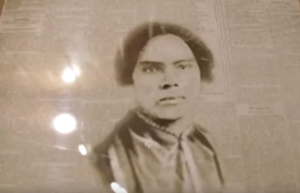By Transformative Justice Coalition
Photos: Transformative Justice Coalition\YouTube Screenshots
As Black History Month celebrations continue, another important figure in African-American history we must honor is: Mary Ann Shadd Cary.
“Mary Ann Shadd Cary, African American teacher, journalist, lawyer, and suffragist, was the oldest of thirteen children of prominent free Black parents. She edited a Canadian newspaper, the Provincial Freeman, for Black refugees who fled to Canada. She advocated the vote for Black women as race advancement, affiliated with the National Woman Suffrage Association, and developed legal arguments for suffrage under the 14th Amendment. Cary founded the Colored Women’s Progressive Franchise Association in D.C. (1880), which pre-dated the woman’s club movement by a decade, and linked the vote to women’s labor questions and entrepreneurship – all ideas far ahead of their time.
The Shadd family moved to Canada after the passage of the Fugitive Slave Act (1850), where she was a spokesperson and editor of the Provincial Freeman. She married Thomas Cary of Toronto but became a widow (1869). She moved to Washington, D. C., taught public school, and became the first woman student at Howard University Law School. Not permitted to graduate because D. C. did not admit women to the bar, she returned ten years later (1883) to receive her law degree at 60.”
Biography
“Mary Ann Shadd Cary was born in Wilmington, Delaware, on October 9, 1823, the oldest of 13 children. Her parents, Abraham Doras and Harriet Parnell Shadd, were elite free black activists. Her shoemaker father, an abolitionist, often hid runaway slaves in the family’s home. In 1832, Abraham was a state representative to the National Convention for the Improvement of Free People of Color in Philadelphia. Abraham and Harriet Shadd believed racial equality could be achieved through education and hard work. However, Delaware, still a slave state in 1832, forbid education for blacks. So at age ten Mary Ann was sent Price’s Boarding School, founded by Quakers, in West Chester, Pennsylvania. Six years later, her education finished, she returned to Delaware where she devoted herself to teaching and ministering to those African Americans who were less fortunate than she.”
“Mary Ann traveled around Canada and the United States, an advocate for full racial integration though education and self-reliance. She promoted emigration to Canada amongst freemen. In 1855 when she attempted to participate in the Philadelphia Colored Convention, the assembly debated whether or not to even allow her to sit as a delegate. She was viewed as a controversial figure because [sic] of her advocacy for emigration. By 15 votes she was admitted and according to Frederick Douglass’ Paper, although she gave a speech advocating for emigration, she was so well received that the delegates voted that she be given ten more minutes to speak. Unfortunately, her presence at the Convention was omitted from the minutes most likely because she was a woman.”
“Cary was teaching in Michigan in 1861 when the North and South went to war. She returned to Canada two years later and became a naturalized British citizen. After the great losses at Gettysburg and Vicksburg, President Lincoln sent out a call for thousands of men to join the Union Army. Cary went to Indiana in the summer of 1863 where she became a recruiting officer to enlist black volunteers.”
“With the war’s close, she returned to teaching as the key to community uplift…For the next four decades, she remained an active feminist and fierce opponent of the racist Jim Crow legislation that scarred post-Civil War U.S.A.. In 1869, as a representative of the city of Detroit, she chaired the Committee on Female Suffrage of the Colored National Labor Convention (Jones, 147). In 1874 she joined other women in an unsuccessful attempt to vote and in 1880 helped create the Colored Women’s Progressive Franchise Association. She also looked to the courts for assistance in securing equal rights.” “”Mary Ann Shadd Cary would eventually become the first Black woman to vote in a national election due to her efforts.” (emphasis in original)
“Throughout the 1880s, Cary continued her fight for voting rights and black freedom. In 1887, she and Frances Watkins were the only blacks included at the Annual Congress of the Association for the Advancement of Women in New York. Once Cary returned to Canada to speak at a Votes for Women rally. Her message was so inflammatory, however, that she was threatened physically and had to flee over the border into Detroit.
Cary never gave up the fight for equality, but she became disillusioned with empty promises by the government to improve the lives of black Americans and with the failure of African Americans themselves to act as a group on their own behalf.”
“Mary Ann Shadd Cary died of stomach cancer in 1893. She was buried in Columbian Harmony Cemetery in Washington, DC.” “Her legacy, however, would not be fully appreciated until feminist and anti-racist scholars began her overdue recovery at the close of the 20th century. ” “In the late 20th century, both Canadian and American feminist and Black civil rights movements claimed her as a heroine, reminding us of the transnational nature of many reform crusades. The Mary Ann Shadd Cary House in Washington, DC, is a National Historic Landmark and the City of Toronto has erected an historical plaque to recognize her contribution. In 1985, Scarborough, Ontario, opened the Mary Shadd Public School. The life of this activist revealed the frequently close links between anti-slavery and women suffrage causes not only in the United States where these are well documented but in Canada as well.”














